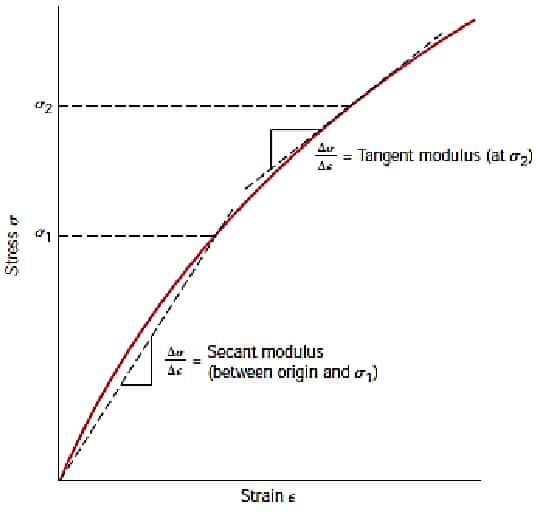Definitions
Elastic deformation (elasticity)
Deformation is temporary. Returns to its original shape when load is released.
Linear elastic materials
When elastic deformation portion in stress-strain diagram is straight line.
Young’s modulus (aka Elastic modulus)
Can be thought of as stiffness.
Nonlinear elastic materials
When elastic deformation portion in stress-strain diagram is not straight line.
Secant modulus
Equal to the tangent of the line connecting a point in the stress-strain diagram and the origin.
Tangent modulus
Equal to the instantaneous tangent on a point in the stress-strain diagram.

Poisson’s ratio
A tensile stress in a particular direction causes extension (say
For metals (if not given) can be taken as
Isotropic materials
Homogenous materials.
Plastic deformation (plasticity)
When stress is not proportional to strain. Deformation is permanent or non-recoverable or plastic.
Yield stress point
The point where plastic deformation starts in stress-strain diagram.
Yield strength
Stress at yield stress point. Denoted by
True yield stress point is very difficult to find practically. Therefore strain offset method is used to find an approximate yield strength.
Strain offset method
A straight line is constructed parallel to the elastic portion of the
stress-strain curve at some specified strain offset. The stress corresponding to
the intersection of this line and the stress-strain curve is defined as the
yield strength
0.2% proof stress
Yield strength when
Tensile strength
After yielding, the stress necessary to continue plastic deformation increases to a maximum, and then decreases.
Ultimate tensile strength (UTS)
The maximum stress that can be sustained by a material in tension.
Toughness
The strain energy absorbed by a material before fracture.
Fracture
Separation of a solid into more than 1 parts under load or stress.
Based on the type of load:
- Tensile fracture
- Compressive fracture
- Shear fracture
- Fatigue fracture
- Creep fracture
Characterized into 2:
- Ductile fracture
- Brittle fracture
Ductile fracture
Materials show significant amount of plastic deformation prior to fracture. Fracture surface gives cup & cone appearance. Aka. cup-and-cone fracture.
Steps:
- Specimen forms a neck
- Cavities start to form within the neck
- Cavities join with each other and form a crack
- Crack propagates towards surface perpendicular to stress
- Direction of crack changes to
Brittle fracture
Little or no plastic deformation prior to fracture. Fracture surface is smooth.
More dangerous than ductile fracture.
- No warning sign
- Crack propagates at very high speeds
- No need for extra stress during crack propagation.
Ductility & Brittleness
Depends on:
- Composition of the material
- Temperature
Ductile to Brittle Transition Temperature
The temperature which a material is:
- brittle below the temperature
- ductile above the temperature
Many steels exhibit this behaviour.